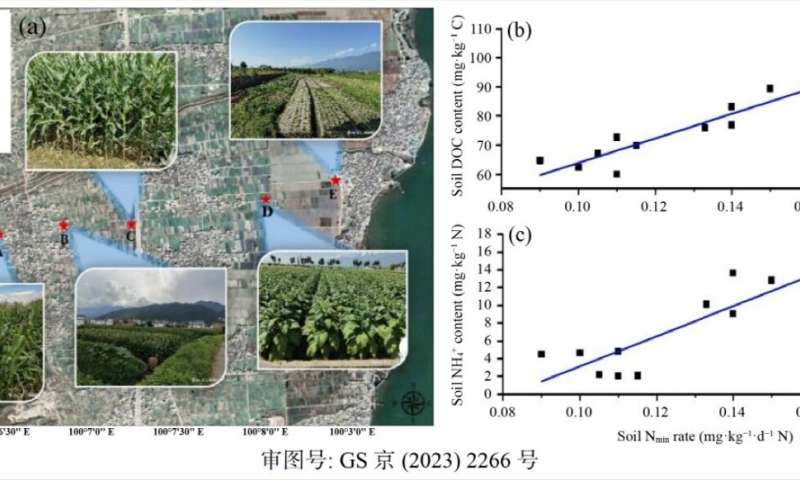Is soil nitrogen mineralization important in agricultural intensive areas?

Soil nitrogen mineralization (Nmin) is a key process that converts organic N into mineral N that controls soil N availability to plants. However, regional assessments of soil Nmin in cropland and its affecting factors are lacking, especially in relation to variation in elevation.
Nitrogen is an essential nutrient for crops but mineral N in soil, the only form that can be absorbed and used by crops, represents only about 1% of total soil N. Although N fertilization is commonly a necessary method for supplying N to crops, N release due to excess N fertilizer in the environment through hydrological and gaseous pathways has been identified as the main obstacle to the global sustainability of food production. In addition, soil Nmin, a key process that converts organic N into mineral N during the activities of microorganisms, is normally essential for adequate N nutrition.
However, a strong Nmin may also lead to excessive amounts of nitrate (NO3–-N) and ammonium nitrogen (NH4+-N) that can be lost in ground surface runoff or leach to groundwater, resulting in water pollution.
Although numerous reports have documented the soil Nmin rate under different land use, such as forestry, grasslands and cropland, regional assessments of soil Nmin and its potential effects on the environment are lacking, especially for agricultural areas with intensive management.
Nitrification (Nit), another important soil N transformation linked to the soil Nmin, contributes greatly to the regulation the N form in soil. Considerable spatial differences exist in soil Nmin and Nit due to wide-ranging influences, Nmin depends on organic matter composition, agricultural management practices, temperature, humidity, pH, ventilation, soil structure, soil fertility and soil microorganisms.
Soil N transformation and Nmin are coupled processes, several studies have investigated the coupling effect between soil Nmin and Nit among different ecosystems. In particular, soil Nmin can be influenced by a number of factors, such as soil pH, soil moisture, total soil N (TN), total carbon (TC), soil C to N ratio (C/N), and different vegetation types. Researchers have investigated the soil Nmin process and its underlying mechanisms in cropland in southern China.
However, a gap still existed when the effects of these factors on the soil Nmin of different cropland differed, especially under spatial variation conditions.
In this study, a four-week incubation experiment was implemented to measure net soil Nmin rate, gross nitrification (Nit) rate and corresponding soil abiotic properties in five field soils (A-C, maize; D, flue-cured tobacco; and E, vegetables; with elevation decreasing from A to E) from different altitudes in a typical intensive agricultural area in Dali City, Yunnan Province, China. The findings are published in the journal Frontiers of Agricultural Science and Engineering.
The results showed that soil Nmin rate ranged from 0.10 to 0.17 mg·kg–1·d–1 N, with the highest value observed in field E, followed by fields D, C, B and A, which indicated that soil Nmin and Nit rates varied between fields decreasing with elevation.
The soil Nit rate ranged from 434.2 to 827.1 µg·kg–1·h–1 N, with the highest value determined in field D, followed by those in fields E, C, B, and A. The rates of soil Nmin and Nit were positively correlated with several key soil parameters, including total soil N, dissolved organic carbon and dissolved inorganic N across all fields, which indicated that soil variables regulated soil Nmin and Nit in cropland fields. In addition, a strong positive relationship was observed between soil Nmin and Nit.
This study provides a greater understanding of the response of soil Nmin among cropland fields related to spatial variation. It is suggested that the soil Nmin from cropland should be considered in the evaluation of the N transformations at the regional scale. The researchers observed that the rates of soil Nmin and Nit were spatially variable across the fields sampled.
In general, the soil Nmin rate and Nit decreased with elevation and were correlated with several key soil parameters, such as soil TN and available C and N for all cropland. The findings indicate that soil Nmin from croplands should be considered in the evaluation of non-point source pollution at a regional scale.
More information:
Peng XU et al, Regional assessment of soil nitrogen mineralization in diverse cropland of a representative intensive agricultural area, Frontiers of Agricultural Science and Engineering (2023). DOI: 10.15302/J-FASE-2023515
Provided by Higher Education Press